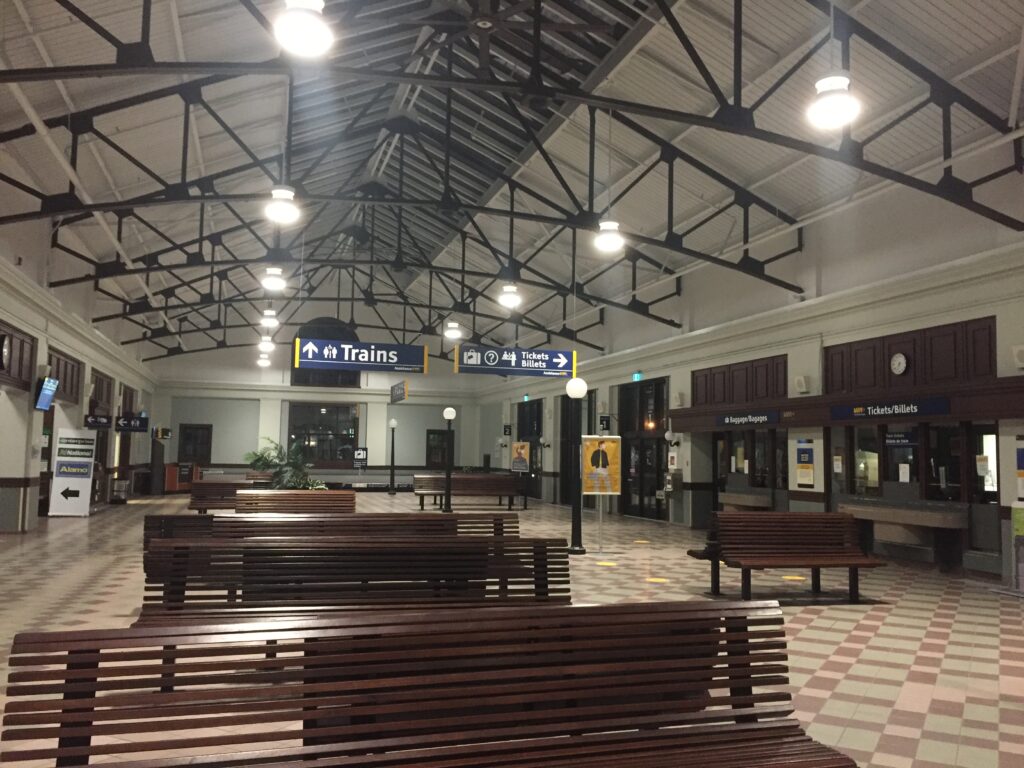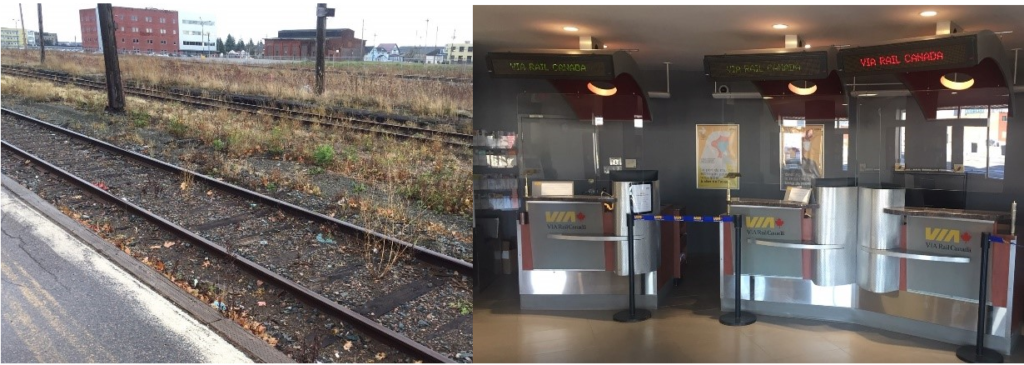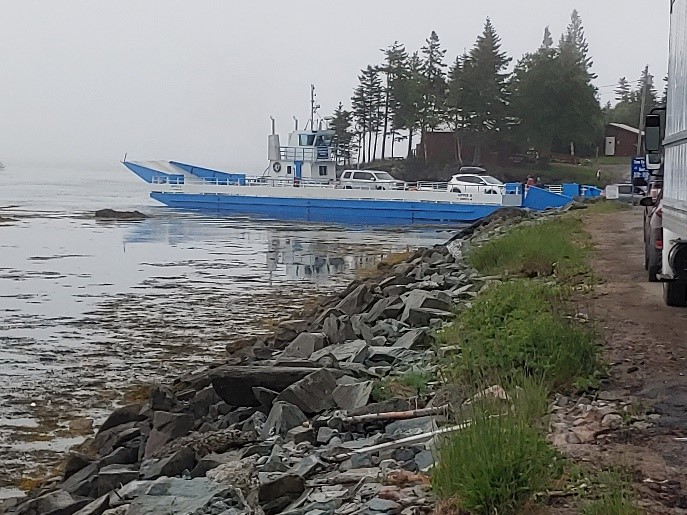Welcome to the December edition of Atlantic Transport News!
Here’s a look at what you’ll find in this edition:
- Passenger carriers impacted as Atlantic Bubble bursts
- Resumption of VIA’s Ocean postponed once again
- VIA reports dismal 3rd quarter; Feds provide emergency funding
- VIA’s Corporate Plan pleads for new equipment
- St. John’s budget cuts take aim at Metrobus service
- TAA renews call for reduced NL ferry rates
- Seasonal Campobello ferry extended to year-end
- NS Liberal leadership candidate pushes highway twinning

PASSENGER CARRIERS IMPACTED AS ATLANTIC BUBBLE BURSTS
The Atlantic Bubble was the COVID-19 success story of North America for summer into autumn of 2020, with our region not having more than five active COVID-19 cases per 100,000 residents on any day over the twenty-week period from when the effective date of July 3rd until November 20th. Meanwhile, residents of the four Atlantic Canadian provinces were free to travel between the provinces without being subject to the 14-day self-isolation required for individuals arriving from outside the region.
But by November 23rd, the number of active cases in the region had ticked up to seven per 100,000, with 85 percent of those located in NB and NS. The upward trend in cases resulted in the Atlantic Bubble collapsing – at least temporarily – with NL and PEI announcing they were suspending the arrangement for at least two weeks. On the same date, each of the other six Canadian provinces had between 90 (Ontario) and 580 (Manitoba) active cases per 100,000 residents. Three days later, NB followed suit in leaving the bubble, and PEI later extended its withdrawal for an additional two weeks to December 21st.
As of December 4th, ten days after the bubble burst, Atlantic Canada had 11 active cases per 100,000 residents, with 88 percent being in NB and NS. That number of active cases has remained steady over the past week, and at this writing there is no one hospitalized from COVID-19 anywhere in the region. It appears unlikely the Atlantic Bubble will be restored until case numbers decrease in the region and the disparity in case numbers between the four provinces decreases.
Not surprisingly, there was an immediate and detrimental effect on inter-provincial carriers in the region. By the end of November, Maritime Bus was reporting a 50% drop in passenger loads on its scaled down schedule, in comparison to a month earlier. Although owner Mike Cassidy isn’t optimistic the bubble will be fully restored before the new year, he’s still determined to operate daily service between December 20 and January 6 (except Christmas Day). He reports that ridership had gone down to between 100 and 150 per operating day, whereas last year at this time the service was averaging about 500 passengers daily. The one bright spot was parcels, which were running well ahead of the volumes from a year ago, and helping to offset some of the lost revenue.
“We just can’t leave the communities without the important services we provide,” says Mr. Cassidy, who takes great pride that Maritime Bus has maintained a reduced schedule without interruption throughout the pandemic. “We’re still operating, and we still have a brand throughout the Maritimes that we’re very proud of.”
Meanwhile, PAL Airlines is also feeling the pinch on its new route between Moncton and St. John’s. The non-stop direct service had been operating five days a week since its launch in September, but has now been temporarily reduced to tri-weekly. Janine Brown, the airline’s director of business development, says they will evaluate later this month based on the limitations imposed by both provincial governments. When travel in and out of Moncton was restricted earlier in the fall, there was an immediate and significant increase in bookings when the restrictions were lifted. The company is anticipating a similar uptick in demand when the current situation improves.

Meanwhile, the airline was recognized by the St. John’s Board of Trade in a unique virtual “Business Resilience Awards” ceremony on December 2. PAL took home the Opportunity Seeker Award, for launching the new YYT-YQM route.
“We saw that there was a gap in Atlantic Canada and that there was a great demand to connect Newfoundland with New Brunswick,” said Ms. Brown in accepting the award. “That required a lot of hard work and dedication from a lot of people during a very challenging time.”
-James Fraser/Ted Bartlett
RESUMPTION OF VIA’S OCEAN POSTPONED ONCE AGAIN

There’s been yet another delay in the projected return to service of VIA Rail’s Ocean. As reported last month, there will be no passenger trains at all east of Quebec City for the 2020 holiday travel season – no great surprise, given the ongoing resurgence of COVID-19 and the continuation of various travel restrictions. Despite initial plans to resume some form of service between Montreal and Halifax as early as November, VIA has continued to shift the resumption date, first blocking the sale of tickets through November and December, and then cancelling trains through the end of the year. As of the time of writing, VIA has now cancelled all Ocean departures through the end of January 2021, and suspended bookings for February and March. This shifts the earliest possible service resumption to February 2021, but it is looking increasingly likely that the train will not resume until COVID-19 concerns recede and travel restrictions ease – perhaps, we can hope, with the roll out of vaccines in early 2021.
With a second wave of the pandemic affecting the Atlantic provinces and renewed travel restrictions in place, there likely won’t be much travel happening over the holidays either way – and various health authorities are certainly discouraging travel even within the region, for all but essential purposes. So the absence of the train won’t be felt as acutely as it would be in more “normal” times, but its ongoing absence highlights the important role it does play in providing connections within the region and to the rest of Canada. TAA will continue to put pressure on VIA to resume this service as soon as it is safe and reasonable to do so, and to make the investments required to support its long-term future.
VIA REPORTS DISMAL 3RD QUARTER; FEDS PROVIDE EMERGENCY FUNDING
The pandemic has not been kind to transportation providers of any form, and VIA has been no exception. Even with many of its services suspended or scaled back and operating expenses significantly reduced, the drop in ridership has had a devastating impact on the railway’s financial performance over the course of this year. In their recently released Q3 report, VIA reported passenger miles down 83.8%, passenger numbers down 82%, and revenue down 83.9% compared to the same quarter in the previous year.
Fortunately, the federal government has stepped in to provide at least bare-bones support for VIA’s bottom line, earmarking $188 million in the fall fiscal update to “…cover operating shortfalls in 2020-21 resulting from the COVID-19 pandemic”. As welcome as this is, it remains only the minimal investment required to keep the railway afloat through this crisis. As highlighted in their recent corporate plan, the federal government will need to do much more to ensure that VIA’s operations can continue (let alone expand) in the future.
VIA’S CORPORATE PLAN PLEADS FOR NEW EQUIPMENT
VIA recently released the summary of their 2020-2024 Corporate Plan:
As usual, this provides a good look at the priorities of the railway over the coming years, and valuable insight into ongoing performance of the corporation. This latest plan has a few positive highlights – there continues to be optimism about the future of VIA’s High Frequency Rail proposal, a new reservation system seems to be finally on the way, and for this end of the country, there is a further acknowledgement that VIA has settled on an operating model for the Ocean to continue service beyond the loss of the Halifax rail loop, even if the new bidirectional train may be a significant downgrade from what came before. There’s also an acknowledgement of plans to return service to the Gaspé once track upgrades by the province of Quebec are complete – potentially within the period covered by this plan.
Unfortunately, any of the optimistic highlights are overshadowed by a more stark analysis of the state of VIA’s operations outside the Corridor. Ongoing struggles with the host railways (primarily CN) have caused continued challenges with on time performance (OTP), especially in the west. On the Canadian, improvements in financial performance stemming from the introduction of Prestige Class several years ago have been wiped out by the OTP struggles, lengthened schedule, and accompanying reticence among tourist operators to book travel.

Undoubtedly the most significant concern in this plan is the acknowledgement of the dire state of the equipment serving on VIA’s non-Corridor and long-distance routes. While VIA had previously committed to further refurbishment of the nearly 70 year old HEP equipment, structural issues discovered earlier in 2020 have cast doubt on the longevity of this fleet and options for further refurbishment – even forcing the cancellation of the comprehensive overhaul of a group of HEP1 coaches to modern accessibility standards.
To quote from the corporate plan: “VIA Rail recognizes that despite the inherent quality of construction and intrinsic longevity of the stainless steel used, it is no longer reasonable to expect an extended service life from the Budd manufactured rolling stock equipment (HEP cars) that is approaching or has exceeded 70 years of age. At some point the effectiveness, usefulness and maintenance costs of any product will reach a point where replacement must be considered and unfortunately this also includes the HEP cars.”
With this in mind, the plan states that “VIA Rail will explore the replacement of its Long-Distance and Regional fleet”, requiring $14.6 million per year to maintain current state of good repair until a renewal program is approved.
The one silver lining here is that VIA is finally, publicly, acknowledging that there is a dire need to start the process to replace the non-Corridor fleet – something advocates like TAA and TAC have been emphasizing for years. With VIA now acknowledging this fact, there is potential that a case can be made to the federal government that new, modern, accessible, and reliable trains are important for every part of the country – not just the Corridor.
We can just hope it won’t be too little, too late.
-Tim Hayman
ST. JOHN’S BUDGET CUTS TAKE AIM AT METROBUS SERVICE
The City of St. John’s is facing a major deficit, partly because of the CIVID-19 pandemic, but also due in part to the massive “Snowmageddon” onslaught earlier this year. As a result, more than $18 million will have to be shaved from the 2021 budget being finalized this month. One of the most conspicuous targets is Metrobus – the transit system that serves the provincial capital and the adjacent communities of Mount Pearl and Paradise. Next year’s subsidy will see a planned cut of $800,000, which means a deferral of plans to increase frequency on several core routes that had intended to increase ridership. More seriously, the service reductions normally in effect each summer when student ridership drops substantially and more people bike or walk will begin in January for 2021– meaning users will have to wait longer for their bus during the year’s worst weather.

PHOTO – Jeremy Eaton, CBC
The plan didn’t sit well with several councillors. Coun. Ian Froude was sufficiently disgusted to resign from the Transportation Commission. His replacement, Coun. Maggie Burton, told TAA the City needs to find other ways to meet the budget shortfall.
“I’m OK with a temporary delay in increasing service levels,” she said, “but cutting service in January is not a smart thing to do. If we reduce service now, ridership will only continue to drop.” She pointed out that half of current Metrobus users are people using the provincially-funded transit pass for lower income residents – the most vulnerable members of society.
“These are difficult choices to make,” said Coun. Dave Lane, Council lead for Finance and Administration who admits to being torn on the issue, in a written statement. “City Council and the St. John’s Transportation Commission remain committed to enhancing our public transit service.
Once we begin to emerge from the pandemic, we will adapt our transit service. We will review the goals and strategies identified during the Public Transit Review process to pursue a long-term recovery plan to improve transit service and attract new riders.”
But Coun. Burton feels that’s cold comfort to transit users left shivering on a bus stop in the midst of a Newfoundland winter.
-Ted Bartlett
TAA RENEWS CALL FOR REDUCED NL FERRY RATES
Transport Action Atlantic is calling on the new premier of Newfoundland and Labrador to initiate discussions with the Government of Canada on Marine Atlantic ferry rates. The issue has been one of growing concern to TAA as the cost recovery level dictated by Transport Canada has far outstripped the national inflation index over the past two decades.
“Without doubt, ferry rates are crucial to the entire population of Newfoundland and Labrador,” says a letter sent to Premier Andrew Furey in mid-October. “In particular, during the pandemic recovery period – with many would-be travellers understandably still apprehensive about flying – affordable Marine Atlantic fares will be critical to rebuilding a healthy and vibrant hospitality industry. We urge you to pursue this vital issue at the earliest opportunity.”
The letter notes that as leader of the opposition, Justin Trudeau obviously concurred with TAA’s view when he wrote to then-premier Paul Davis during the 2015 federal election campaign. He committed that a Liberal government would address this issue, noting that the ferry service “is not only a vital part of Newfoundland and Labrador’s economy, but also serves as an extension of the Trans Canada Highway.”
Five years later, there has been no sign of any action on this pledge. In fact, the province’s six Liberal MPs prefer to pretend the commitment was never made, as annual ferry rate increases have continued unabated. The letter to Premier Furey acknowledges that there are undoubtedly many other areas where federal financial assistance is being sought for the cash-strapped province. But that should not be a factor, TAA maintains.
“More than 70 years after Newfoundland joined Canada, the level transportation playing field envisaged by the latter-day Fathers of Confederation who drafted the Terms of Union has been severely compromised. Term 32 is a constitutional matter, and its intent has been clearly distorted under successive federal governments. The Province should not have to remain silent on this issue as a condition for obtaining help from Ottawa on other pressing financial challenges.”
TAA has not yet received any response from the Premier’s Office on the matter.
-Ted Bartlett
SEASONAL CAMPOBELLO FERRY EXTENDED TO YEAR-END

New Brunswick’s Campobello Island continues to face difficulties in securing access to goods and services taken for granted on the mainland. The island’s 700 residents are connected by an international bridge with the town of Lubec, Maine, but their only link to the rest of the province is via a seasonal ferry to nearby Deer Island. With border restrictions and provincial registrations required up to five days in advance to perform tasks like accessing a bank or gas station, the privately owned and operated barge has continued a four-days-per-week service into the fall with a subsidy to the tune of $60,000 per month from the provincial government. Unfortunately, due to the lack of proper vessel and landing infrastructure, the service has been unreliable.
Since September 21st, East Coast Ferries has had 48 scheduled operation days. Of those 48, only 26 days were fully realized as 11 days were partially lost and another 11 were totally lost due to weather and mechanical issues. A larger, more capable vessel and adequate landing infrastructure would likely have reduced the lost days to zero. The federal government has offered to contribute to the project, but Premier Higgs has evidently backed away from his May 2020 promise to pursue a year-round service plan for submission to Ottawa, and Transportation Minister Jill Green has not returned calls and e-mails requesting a conversation.
-Justin Tinker
HARDLY A PROGRESSIVE PLATFORM!
And a parting shot across the bow of Nova Scotia Liberal Party leadership candidate Labi Kousoulis. The former cabinet minister surely isn’t going to make many friends among environmentalists – or even the progressive wing of his own party – with campaign promises like one he released just the other day.
Mr. Kousoulis says he will embark on an ambitious road-twinning program if he wins the party leadership and becomes premier in February. His plan would eventually see four-lane highways all the way from Yarmouth to the Cape Breton Regional Municipality. How’s that for spending money Nova Scotia clearly doesn’t have on so-called “assets” that the province couldn’t afford to maintain?
Hopefully his opponents in the leadership race hold more progressive views on sustainable transportation!










